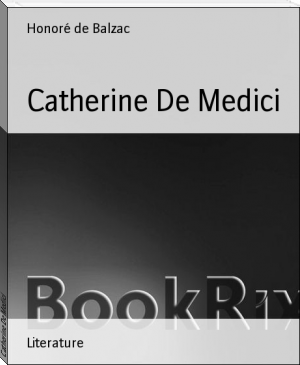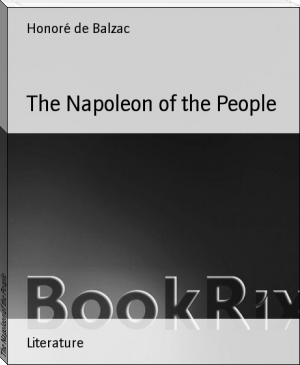Catherine De Medici, Honoré de Balzac [best short novels of all time TXT] 📗

- Author: Honoré de Balzac
Book online «Catherine De Medici, Honoré de Balzac [best short novels of all time TXT] 📗». Author Honoré de Balzac
"You who are so wise and have seen so many things," said Babette, timidly, "explain to me what the Reformers really want."
"Yes, tell us that, crony," cried the jeweller. "I knew the late king's tailor, and I held him to be a man of simple life, without great talent; he was something like you; a man to whom they'd give the sacrament without confession; and behold! he plunged to the depths of this new religion,--he! a man whose two ears were worth all of a hundred thousand crowns apiece. He must have had secrets to reveal to induce the king and the Duchesse de Valentinois to be present at his torture."
"And terrible secrets, too!" said the furrier. "The Reformation, my friends," he continued in a low voice, "will give back to the bourgeoisie the estates of the Church. When the ecclesiastical privileges are suppressed the Reformers intend to ask that the _vilain_ shall be imposed on nobles as well as on burghers, and they mean to insist that the king alone shall be above others--if indeed, they allow the State to have a king."
"Suppress the Throne!" ejaculated Lallier.
"Hey! crony," said Lecamus, "in the Low Countries the burghers govern themselves with burgomasters of their own, who elect their own temporary head."
"God bless me, crony; we ought to do these fine things and yet stay Catholics," cried the jeweller.
"We are too old, you and I, to see the triumph of the Parisian bourgeoisie, but it will triumph, I tell you, in times to come as it did of yore. Ha! the king must rest upon it in order to resist, and we have always sold him our help dear. The last time, all the burghers were ennobled, and he gave them permission to buy seignorial estates and take titles from the land without special letters from the king. You and I, grandsons of the Goix through our mothers, are not we as good as any lord?"
These words were so alarming to the jeweller and the two women that they were followed by a dead silence. The ferments of 1789 were already tingling in the veins of Lecamus, who was not yet so old but what he could live to see the bold burghers of the Ligue.
"Are you selling well in spite of these troubles?" said Lallier to Mademoiselle Lecamus.
"Troubles always do harm," she replied.
"That's one reason why I am so set on making my son a lawyer," said Lecamus; "for squabbles and law go on forever."
The conversation then turned to commonplace topics, to the great satisfaction of the jeweller, who was not fond of either political troubles or audacity of thought.
III. THE CHATEAU DE BLOIS
The banks of the Loire, from Blois to Angers, were the favorite resort of the last two branches of the royal race which occupied the throne before the house of Bourbon. That beautiful valley plain so well deserves the honor bestowed upon it by kings that we must here repeat what was said of it by one of our most eloquent writers:--
"There is one province in France which is never sufficiently
admired. Fragrant as Italy, flowery as the banks of the
Guadalquivir, beautiful especially in its own characteristics,
wholly French, having always been French,--unlike in that respect
to our northern provinces, which have degenerated by contact with
Germany, and to our southern provinces, which have lived in
concubinage with Moors, Spaniards, and all other nationalities
that adjoined them. This pure, chaste, brave, and loyal province
is Touraine. Historic France is there! Auvergne is Auvergne,
Languedoc is only Languedoc; but Touraine is France; the most
national river for Frenchmen is the Loire, which waters Touraine.
For this reason we ought not to be surprised at the great number
of historically noble buildings possessed by those departments
which have taken the name, or derivations of the name, of the
Loire. At every step we take in this land of enchantment we
discover a new picture, bordered, it may be, by a river, or a
tranquil lake reflecting in its liquid depths a castle with
towers, and woods and sparkling waterfalls. It is quite natural
that in a region chosen by Royalty for its sojourn, where the
court was long established, great families and fortunes and
distinguished men should have settled and built palaces as grand
as themselves."
But is it not incomprehensible that Royalty did not follow the advice indirectly given by Louis XI. to place the capital of the kingdom at Tours? There, without great expense, the Loire might have been made accessible for the merchant service, and also for vessels-of-war of light draught. There, too, the seat of government would have been safe from the dangers of invasion. Had this been done, the northern cities would not have required such vast sums of money spent to fortify them,--sums as vast as were those expended on the sumptuous glories of Versailles. If Louis XIV. had listened to Vauban, who wished to build his great palace at Mont Louis, between the Loire and the Cher, perhaps the revolution of 1789 might never have taken place.
These beautiful shores still bear the marks of royal tenderness. The chateaus of Chambord, Amboise, Blois, Chenonceaux, Chaumont, Plessis-les-Tours, all those which the mistresses of kings, financiers, and nobles built at Veretz, Azay-le-Rideau, Usse, Villandri, Valencay, Chanteloup, Duretal, some of which have disappeared, though most of them still remain, are admirable relics which remind us of the marvels of a period that is little understood by the literary sect of the Middle-agists.
Among all these chateaus, that of Blois, where the court was then staying, is one on which the magnificence of the houses of Orleans and of Valois has placed its brilliant sign-manual,--making it the most interesting of all for historians, archaeologists, and Catholics. It was at the time of which we write completely isolated. The town, enclosed by massive walls supported by towers, lay below the fortress,--for the chateau served, in fact, as fort and pleasure-house. Above the town, with its blue-tiled, crowded roofs extending then, as now, from the river to the crest of the hill which commands the right bank, lies a triangular plateau, bounded to the west by a streamlet, which in these days is of no importance, for it flows beneath the town; but in the fifteenth century, so say historians, it formed quite a deep ravine, of which there still remains a sunken road, almost an abyss, between the suburbs of the town and the chateau.
It was on this plateau, with a double exposure to the north and south, that the counts of Blois built, in the architecture of the twelfth century, a castle where the famous Thibault de Tircheur, Thibault le Vieux, and others held a celebrated court. In those days of pure fuedality, in which the king was merely _primus inter pares_ (to use the fine expression of a king of Poland), the counts of Champagne, the counts of Blois, those of Anjou, the simple barons of Normandie, the dukes of Bretagne, lived with the splendor of sovereign princes and gave kings to the proudest kingdoms. The Plantagenets of Anjou, the Lusignans of Poitou, the Roberts of Normandie, maintained with a bold hand the royal races, and sometimes simple knights like du Glaicquin refused the purple, preferring the sword of a connetable.
When the Crown annexed the county of Blois to its domain, Louis XII., who had a liking for this residence (perhaps to escape Plessis of sinister memory), built at the back of the first building another building, facing east and west, which connected the chateau of the counts of Blois with the rest of the old structures, of which nothing now remains but the vast hall in which the States-general were held under Henri III.
Before he became enamoured of Chambord, Francois I. wished to complete the chateau of Blois by adding two other wings, which would have made the structure a perfect square. But Chambord weaned him from Blois, where he built only one wing, which in his time and that of his grandchildren was the only inhabited part of the chateau. This third building erected by Francois I. is more vast and far more decorated than the Louvre, the chateau of Henri II. It is in the style of architecture now called Renaissance, and presents the most fantastic features of that style. Therefore, at a period when a strict and jealous architecture ruled construction, when the Middle Ages were not even considered, at a time when literature was not as clearly welded to art as it is now, La Fontaine said of the chateau de Blois, in his hearty, good-humored way: "The part that Francois I. built, if looked at from the outside, pleased me better than all the rest; there I saw numbers of little galleries, little windows, little balconies, little ornamentations without order or regularity, and they make up a grand whole which I like."
The chateau of Blois had, therefore, the merit of representing three orders of architecture, three epochs, three systems, three dominions. Perhaps there is no other royal residence that can compare with it in that respect. This immense structure presents to the eye in one enclosure, round one courtyard, a complete and perfect image of that grand presentation of the manners and customs and life of nations which is called Architecture. At the moment when Christophe was to visit the court, that part of the adjacent land which in our day is covered by a fourth palace, built seventy years later (by Gaston, the rebellious brother of Louis XIII., then exiled to Blois), was an open space containing pleasure-grounds and hanging gardens, picturesquely placed among the battlements and unfinished turrets of Francois I.'s chateau.
These gardens communicated, by a bridge of a fine, bold construction (which the old men of Blois may still remember to have seen demolished) with a pleasure-ground on the other side of the chateau, which, by the lay of the land, was on the same level. The nobles attached to the Court of Anne de Bretagne, or those of that province who came to solicit favors, or to confer with the queen as to the fate and condition of Brittany, awaited in this pleasure-ground the opportunity for an audience, either at the queen's rising, or at her coming out to walk. Consequently, history has given the name of "Perchoir aux Bretons" to this piece of ground, which, in our day, is the fruit-garden of a worthy bourgeois, and forms a projection into the place des Jesuites. The latter place was included in the gardens of this beautiful royal residence, which had, as we have said, its upper and its lower gardens. Not far from the place des Jesuites may still be seen a pavilion built by Catherine de' Medici, where, according to the historians of Blois, warm mineral baths were placed for her to use. This detail enables us to trace the very irregular disposition of the gardens, which went up or down according to the undulations of the ground, becoming extremely intricate around the chateau,--a fact which helped to give it strength, and caused, as we shall see, the discomfiture of the Duc de Guise.
The gardens were reached from the chateau through external and internal galleries, the most important of which was called the "Galerie des Cerfs" on account of its decoration. This gallery led to the





Comments (0)